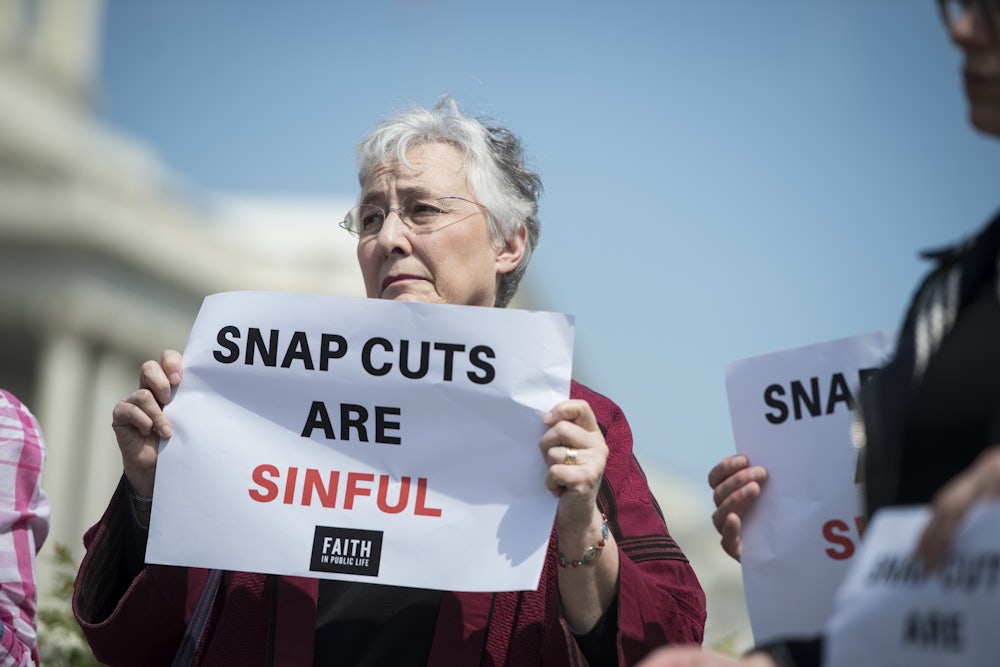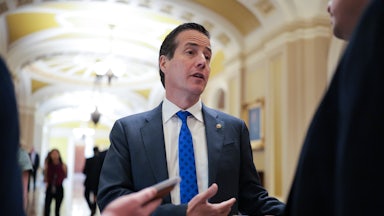It was barely three months ago, on Independence Day, that President Trump signed his so-called One Big Beautiful Bill. The budget law was gargantuan indeed: 330 pages of handouts to the rich and de facto cuts to critical programs for poor and working-class Americans. Among the latter: strict new work requirements for the Supplemental Nutritional Assistance Program that were patently designed to deprive people of the benefit.
It takes federal agencies and states many months, at minimum, and in some cases years to adjust to changes in such massive legislation (look no further than the implementation of President Biden’s Inflation Reduction Act). And yet, late last Friday, the administration quietly published guidance from the Agriculture Department saying that states must implement the new SNAP requirements by November 1, an impossibly tight deadline. The fast turnaround almost certainly means states will struggle to meet it and could make mistakes, kicking people off SNAP—commonly, if anachronistically, referred to as food stamps—even if they are still eligible to receive it.
“All of this will lead to unnecessary chaos and confusion in the midst of widespread uncertainty, record inflation, and a government shutdown,” the Food Research and Action Center, an anti-hunger nonprofit, said in a statement. That’s unlikely to bother Republicans, because almost every change they’ve made since taking control of the federal government this year has ensured that more Americans will go without the basics, including food. As with cuts to other anti-poverty programs like Medicaid, kicking people off SNAP won’t just be bad for the people who lose access to the program. It will be bad for the communities they live in and, ultimately, for the United States as a whole.
Trump’s budget law cut some of the exemptions for meeting the program’s work requirements. Right now, a childless adult aged 18 to 54 must work or volunteer at least 80 hours a month or be kicked off SNAP after three months. But there are broad exceptions for people with children under 18 in their households, people with disabilities, pregnant women, the unhoused, veterans, and young adults up to age 24 who exited the foster care system at 18. The “one big, beautiful bill” lowers the age of dependent children to 14, raises the age of the work requirement to 64, and ends the exemptions for veterans, homeless people, and young adults out of foster care.
As the Food Research and Action Center points out, this means that families with teenagers older than 14, or grandparents who retired early to help care for their grandchildren, will suddenly find themselves without food. So will many veterans and the unhoused population. A Congressional Budget Office report estimates that 2.4 million people could lose their food assistance.
But the rushed implementation likely will mean even more people who aren’t subject to the stricter requirements will get kicked off because they have to complete new paperwork or verify their status, all while states are overburdened rushing to implement the changes. That’s what work requirements to anti-poverty programs do more than anything else: They increase paperwork, and more paperwork means more opportunities for mistakes and lost applications. States were already struggling to be able to make the changes even without the deadline, and now their job is even harder.
States will also face increased pressure to get everything right because the mistakes they make could count against them in the future. Beginning in 2028, they will have to share some of the costs of SNAP with the federal government, and their error rates will determine how much. Funding anti-poverty programs like SNAP is harder for states than the federal government, which means the program will be further jeopardized.
This is coming at a time when grocery prices are much higher than they were five years ago, Trump’s tariffs are only beginning to kick in, and a government shutdown has jeopardized another big nutrition assistance program for women, infants, and children, WIC. And we might not even understand the scale of the damage in the coming months because the administration has scrapped an important food insecurity report that provided data on hunger in the United States.
But the cuts to programs like SNAP are bad for everyone—not just those who currently receive food assistance. SNAP is one of the few entitlements left: Anyone who needs it can access the program as long as they fall below the income limits, and program spending grows to cover the need. That means that families don’t have to stay on waiting lists because there aren’t enough funds to help everyone who qualifies, as they do now with other programs like childcare subsidies or rental assistance. When a job loss, divorce, or death in the family upends their financial stability, food aid is usually there for them relatively quickly.
SNAP thus performs the critical function of helping to prop up the economy during times of crisis, like a recession, or in local areas when a factory closes and unemployment spikes. Even in normal times, communities that experience high rates of hunger, like rural areas, rely on the nutrition programs to buoy the local economy, keeping grocery stores and small farm stands in business. By some estimates, every dollar spent on food stamps results in a $1.54 boost in the economy. During more dire times, the program pumps even more money through the economy.
Republicans have, per usual, portrayed these work requirements as commonsense reforms to reduce fraud and waste. But many of the people who receive SNAP are already working, yet can’t make enough to feed their families and can’t do anything to improve the job market where they live. Many others have caregiving duties that are more pressing than work, or health problems that will only be made worse if they don’t have enough to eat. And SNAP actually has the opposite problem: Only an estimated 88 percent of the people eligible for it apply and receive the benefit, so the issue is not that too many people are benefiting from the program but that too few are.
Making work requirements stricter also misses the fundamental point of SNAP and other anti-poverty programs. The goal is not to get people into jobs, or even to end poverty. Programs like SNAP and WIC are based on a simple, noble belief: No one in the wealthiest country in the world, with such agricultural abundance, should worry for food or go hungry. But it’s also based on a practical—even commonsense, you might say—idea: It’s hard to find a job, or do your existing job well, when you’re worried about where your next meal will come from.






